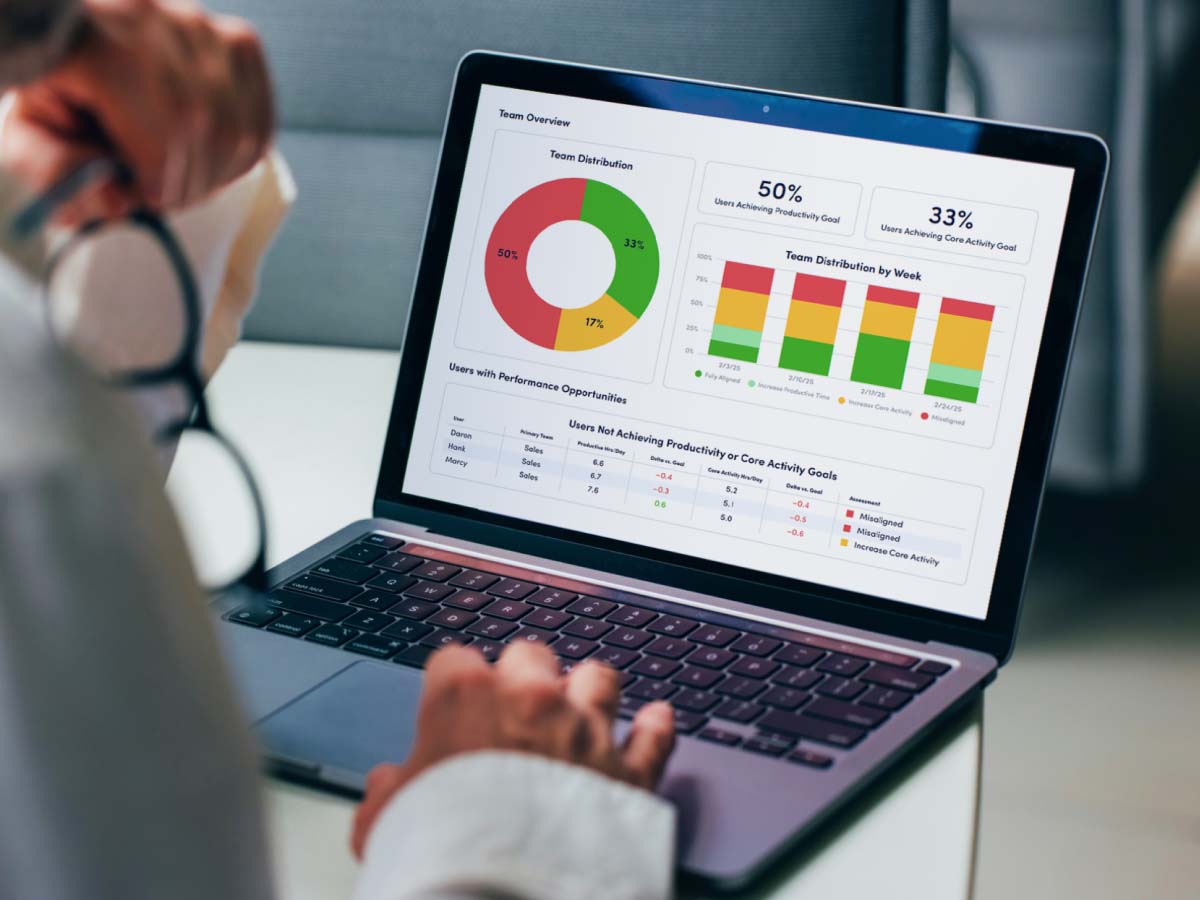The concepts of employee surveillance and monitoring have become hot topics in today’s corporate landscape. As organizations strive to increase productivity, ensure security and maintain compliance while offering flexibility and autonomy to employees, the methods organizations use to quantify and manage workplace activity are under scrutiny. Both employers and employees need to understand the distinctions between surveillance and monitoring to shape workplace culture and influence trust.
While both terms may seem interchangeable at first glance, they embody different philosophies and practices. In this post, we explore the nuances of employee surveillance and monitoring, their definitions, applications and implications in the workplace.
What is employee surveillance?
Employee surveillance refers to the continuous, often covert, observation of employee behavior and activity. It’s typically implemented through methods like video recording, badge access logs, GPS tracking or keystroke logging — often without proactive disclosure. While the intent is usually to protect company assets, ensure compliance or prevent misconduct, this approach erodes employee trust if not handled with transparency and purpose.
Surveillance takes many forms, from physical monitoring in the workplace to digitally tracking online behavior. It serves as a tool for protecting company assets and maintaining security, but also raises ethical questions regarding privacy and trust. Employers who use surveillance must navigate the complexities carefully to avoid infringing on employees’ rights or gaining a reputation for acting like “big brother.”
Legal and ethical considerations of employee surveillance
Leaders must consider several legal and ethical considerations before implementing employee surveillance systems. In many places, serious laws govern what employers can and can’t do when it comes to watching their employees. In some regions, companies must notify employees about surveillance measures. In others, organizations must gain consent from employees before surveilling them or face heavy penalties. For example, White Castle recently faced a $17 billion fine in Illinois for requiring employees to scan their fingerprints to access pay stubs and sharing those images externally without notifying them.
Ethically, organizations must balance their need for security with respect for employee privacy. By communicating transparently, organizations help mitigate concerns and foster a more trusting workplace atmosphere. Employers must strive to create policies that prioritize both company security and respect for employee privacy.
What is employee monitoring?
Employee monitoring is the practice of using workforce analytics to gain visibility into work habits, productivity patterns and operational efficiency — with full awareness and consent of employees. Unlike covert surveillance, monitoring is rooted in transparency and used to drive informed decision-making — not to micromanage or spy on employees.
Effective monitoring doesn’t mean watching every move. Instead, it provides leaders with insights to identify inefficiencies, burnout risks or opportunities to better align workloads with team capacity. When implemented ethically and with clear communication, monitoring becomes a tool for enablement — not control. It helps employees understand their own work patterns while giving managers actionable data to support productivity, engagement and well-being.
Legal and ethical considerations of employee monitoring
While employee monitoring is generally less invasive than surveillance, managers must still keep legal and ethical considerations in mind. Namely, organizations must prioritize employee privacy and follow local regulations about consent and information sharing. For example, employers need to appropriately collect and store data, even if it’s from company-owned devices. They also need to ensure data is only shared with authorized stakeholders for legitimate business purposes.
Open communication and feedback about employee monitoring systems helps employers build trust among employees while gaining buy-in for using them to improve productivity and the employee experience.
Key differences between surveillance and monitoring
While both surveillance and monitoring involve observing employee activities, they take fundamentally different approaches that dramatically impact workplace culture. Understanding these distinctions makes it easier to select the right strategy — one that builds trust rather than eroding it.
| Employee monitoring | Employee surveillance | |
| Purpose | To improve performance, productivity and well-being with data-driven insights | To prevent misconduct or protect assets through close observation |
| Transparency | Fully disclosed, with employee awareness and often participation | Often undisclosed or only partially disclosed |
| Impact on workplace culture | Feels supportive and empowering when aligned with development goals | Can feel invasive, controlling and demoralizing |
| Legality | Requires secure handling of collected information and encourages transparency through clear policies | Carries higher legal risk when conducted without explicit disclosure or proper consent mechanisms |
| Company reputation | Increases trust and attracts better talent when implemented properly | Can create public relations backlash and poor reputation among potential employees |
Intent and purpose
The intent of employee surveillance is security and compliance. Organizations often resort to surveillance methods to protect assets, prevent misconduct and ensure employees adhere to policies. This approach creates a climate of fear and mistrust if it’s mismanaged.
On the other hand, employee monitoring focuses on enhancing performance and supporting employee development. The goal is to provide feedback and insights that help employees improve skills and productivity. When organizations approach monitoring positively, it fosters a culture of growth and collaboration.
Methodology and tools
Surveillance typically employs more invasive tools, such as video cameras and keyboard stroke-logging software, which may operate without employee knowledge. These methods create a sense of being constantly watched, which is detrimental to employee morale.
Monitoring tools prioritize collaboration and clarity. Organizations introduce workforce analytics software, for example, with employee awareness and consent, paired with clear messaging about purpose and benefits. They use the data collected to guide coaching, workload balancing and better decision-making — not to micromanage.
Impact on workplace culture
Surveillance significantly impacts workplace culture. When employees feel they’re under constant scrutiny, they face anxiety, reduced morale and lack of trust in leadership. This ultimately affects productivity and employee retention. Ironically, the Harvard Business Review found that employee surveillance, like keystroke logging and video surveillance, make employees want to break rules more often.
Conversely, effective and transparent monitoring practices lead to a more engaged workforce. When employees feel supported and valued through constructive feedback, they’re more likely to be motivated and committed to their roles. This enhances collaboration, innovation and overall organizational success. In fact, Forbes recently shared that employees report a 39% increase in productivity when their organization employs monitoring software.
Legality and regulatory implications
Surveillance carries greater legal risk due to its often undisclosed nature. Employers must understand and comply with consent laws, data privacy regulations and restrictions on when and how surveillance is permissible. Missteps result in fines and reputational damage.
Monitoring still requires strict attention to compliance — especially when it comes to collecting, storing and sharing data. However, the risk is generally lower when transparency and consent are foundational. Clear policies and responsible data handling are non-negotiable, even when employees are informed and involved.
Effects on company reputation
Employee surveillance has detrimental effects on a company’s reputation, especially if methods are found to be invasive or breach regulations. Employees who leave a company because of its surveillance methods may also warn potential employees about the issues, which further hurt the company’s ability to attract top talent.
When implemented thoughtfully, employee monitoring enhances company reputation. It demonstrates a commitment to transparency, employee development and responsible data practices. By using monitoring to support productivity, well-being and growth rather than control, organizations are more likely to retain talent — and attract future hires through employee advocacy and a strong workplace reputation.
Best practices for implementing monitoring without surveillance
Choosing to implement employee monitoring over surveillance is a step in the right direction, but how it’s executed makes all the difference. To avoid veering into invasive territory, organizations should follow a few essential best practices.
Establish clear policies
Start with comprehensive, well-documented policies that define the purpose, scope and tools involved in monitoring. Clarify what data you’re collecting, how you use it and what rights employees have. Transparency isn’t just a legal safeguard — it’s a foundation for trust. Involving employees in the development process increases buy-in and uncovers blind spots leadership might miss.
Communicate openly
Announce monitoring initiatives with clarity. Explain the business rationale, how it supports employees and what safeguards you put in place to protect privacy. Don’t stop the conversation after rollout — maintain an open dialogue. Invite feedback, answer questions and adjust the approach as tools evolve or business needs shift. Ongoing communication reinforces trust and demonstrates a people-first mindset.
Focus on employee development
When implementing monitoring practices, it’s important to prioritize employee development rather than focusing solely on compliance. Help employees feel supported and engaged in their roles by using monitoring to provide constructive feedback and development opportunities instead of enforcing rules. This approach benefits the organization and contributes to employee satisfaction and retention.
Get monitoring insights without surveillance with ActivTrak
Surveillance might be necessary in highly regulated industries, but most organizations achieve similar outcomes with a more balanced, trust-first approach.
ActivTrak’s employee monitoring software empowers teams with transparent monitoring tools that deliver the visibility leaders need, without compromising employee privacy. Track productivity, engagement and performance with real-time insights, automated time tracking and personal dashboards. Equip employees and managers alike to optimize work habits, improve focus and make data-driven decisions.
Start for free today and discover how ActivTrak helps you drive performance and accountability, without sacrificing trust or culture.





